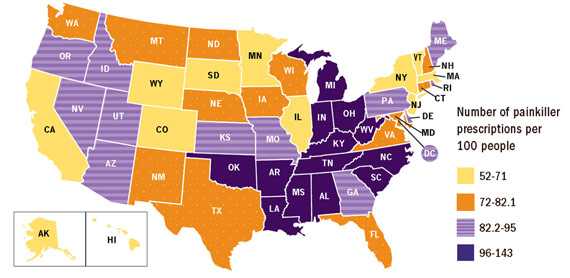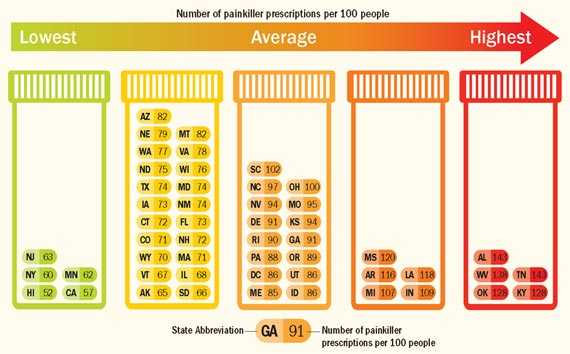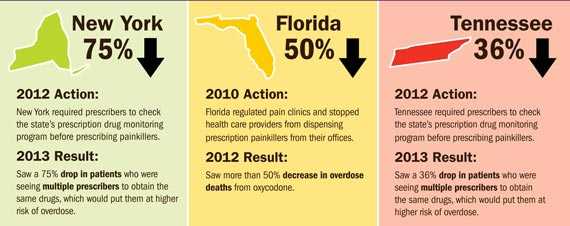Opioid Painkiller Prescribing
Where You Live Makes a Difference
July 2014


 46
46
Each day, 46 people die from an overdose of prescription painkillers* in the US.
 259 M
259 M
Health care providers wrote 259 million prescriptions for painkillers in 2012, enough for every American adult to have a bottle of pills.
 10
10
10 of highest prescribing states for painkillers are in the South.
Health issues that cause people pain don't vary much from place to place—not enough to explain why, in 2012, health care providers in the highest-prescribing state wrote almost 3 times as many opioid painkiller prescriptions per person as those in the lowest prescribing state in the US. Or why there are twice as many painkiller prescriptions per person in the US as in Canada. Data suggest that where health care providers practice influences how they prescribe. Higher prescribing of painkillers is associated with more overdose deaths. More can be done at every level to prevent overprescribing while ensuring patients' access to safe, effective pain treatment. Changes at the state level show particular promise.
States can
- Consider ways to increase use of prescription drug monitoring programs, which are state-run databases that track prescriptions for painkillers and can help find problems in overprescribing. Use of these programs is greater when they make data available in real-time, are universal (used by all prescribers for all controlled substances), and are actively managed (for example, send alerts to prescribers when problems are identified).
- Consider policy options (including laws and regulation) relating to pain clinics (facilities that specialize in pain treatment) to reduce prescribing practices that are risky to patients.
* "Prescription painkillers" refers to opioid or narcotic pain relievers, including drugs such as Vicodin (hydrocodone+acetaminophen), OxyContin (oxycodone), Opana (oxymorphone), and methadone.
Problem
An increase in painkiller prescribing is a key driver of the increase in prescription overdoses.
Health care providers in some states prescribed far more painkillers than those in other states in 2012.
- Southern states had the most prescriptions per person for painkillers, especially Alabama, Tennessee, and West Virginia.
- The Northeast, especially Maine and New Hampshire, had the most prescriptions per person for long-acting and high-dose painkillers.
- Nearly 22 times as many prescriptions were written for oxymorphone (a specific type of painkiller) in Tennessee as were written in Minnesota.
What might be causing this?
- Health care providers in different parts of the country don't agree on when to use prescription painkillers and how much to prescribe.
- Some of the increased demand for prescription painkillers is from people who use them nonmedically (using drugs without a prescription or just for the high they cause), sell them, or get them from multiple prescribers at the same time.
- Many states report problems with for-profit, high-volume pain clinics (so-called "pill mills") that prescribe large quantities of painkillers to people who don't need them medically.
Some states have more painkiller prescriptions per person than others.

SOURCE: IMS, National Prescription Audit (NPATM), 2012.
Infographic
Health care providers in different states prescribe at different levels.

SOURCE: IMS, National Prescription Audit (NPATM), 2012.
Making a Difference: State Successes

SOURCES: NY, TN: PDMP Center of Excellence at Brandeis University, 2014. FL: Vital Signs Morbidity and Mortality Weekly Report, July 1, 2014.
What Can Be Done
Federal government is
- Supporting states that want to develop programs and policies to prevent prescription painkiller overdose, while ensuring patients' access to safe, effective pain treatment.
- Improving patient safety by supplying health care providers with data, tools, and guidance for decision making based on proven practices.
- Increasing access to mental health and substance abuse treatment through the Affordable Care Act.
States can
- Consider ways to increase use of prescription drug monitoring programs, which are state-run databases that track prescriptions for painkillers and can help find problems in overprescribing. Use of these programs is greater when they make data available in realtime, are universal (used by all prescribers for all controlled substances), and are actively managed (for example, send alerts to prescribers when problems are identified).
- Consider policy options (including laws and regulation) relating to pain clinics to reduce prescribing practices that are risky to patients.
- Evaluate their own data and programs and consider ways to assess their Medicaid, workers' compensation programs, and state-run health plans to detect and address inappropriate prescribing of painkillers.
- Identify opportunities to increase access to substance abuse treatment and consider expanding first responder access to naloxone, a drug used when people overdose.
Health care providers can
- Use prescription drug monitoring programs to identify patients who might be misusing their prescription drugs, putting them at risk for overdose.
- Use effective treatments such as methadone or buprenorphine for patients with substance abuse problems.
- Discuss with patients the risks and benefits of pain treatment options, including ones that do not involve prescription painkillers.
- Follow best practices for responsible painkiller prescribing, including:
- Screening for substance abuse and mental health problems.
- Avoiding combinations of prescription painkillers and sedatives unless there is a specific medical indication.
- Prescribing the lowest effective dose and only the quantity needed depending on the expected length of pain.
Everyone can
- Avoid taking prescription painkillers more often than prescribed.
- Dispose of medications properly, as soon as the course of treatment is done, and avoid keeping prescription painkillers or sedatives around "just in case."
- Help prevent misuse and abuse by not selling or sharing prescription drugs. Never use another person's prescription drugs.
- Get help for substance abuse problems 1-800-662-HELP. Call Poison Help 1-800-222-1222 if you have questions about medicines.
Science Behind the Issue
Related Pages
- Vital Signs: Prescription Painkiller Overdoses: A Growing Epidemic, Especially Among Women
- Vital Signs: Prescription Painkiller Overdoses: Use and Abuse of Methadone as a Painkiller
- Vital Signs: Prescription Painkiller Overdoses in the US
- Prescription Drug Overdose
- Policy Impact: Prescription Painkiller Overdoses
- Common Elements in Guidelines for Prescribing Opioids for Chronic Pain
On Other Web Sites
- MedlinePlus – Prescription Drug Abuse
- MedlinePlus – Pain Relievers
- The White House – Office of National Drug Control Policy
- SAMHSA – Substance Abuse and Mental Health Services Administration
- Drug Enforcement Administration – Office of Diversion Control
- National Institute on Drug Abuse
- Prescription Drugs
- U.S. Food and Drug Administration – Drugs Information
- National Institute of Mental Health
- PDMP Center of Excellence, Brandeis University
- The Dartmouth Atlas of Health Care
- National Alliance for Model State Drug Laws
- Office of the National Coordinator for Health Information Technology (ONC) – Linking PDMPs to Health IT
- Prescription Drug Monitoring Program Initiative
- National Action Plan for Adverse Drug Event Prevention
- CMS Improvements to Medicare Drug and Health Plans
- Page last reviewed: July 1, 2014
- Page last updated: July 1, 2014
- Content source:
- National Center for Injury Prevention and Control, Division of Unintentional Injury Prevention
- Page maintained by: Office of the Associate Director for Communications (OADC)


 ShareCompartir
ShareCompartir